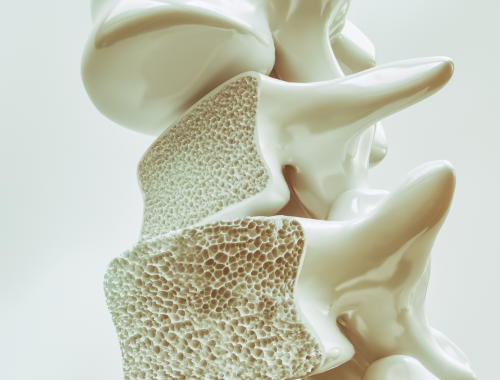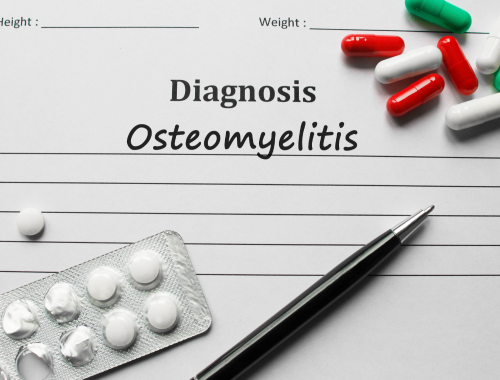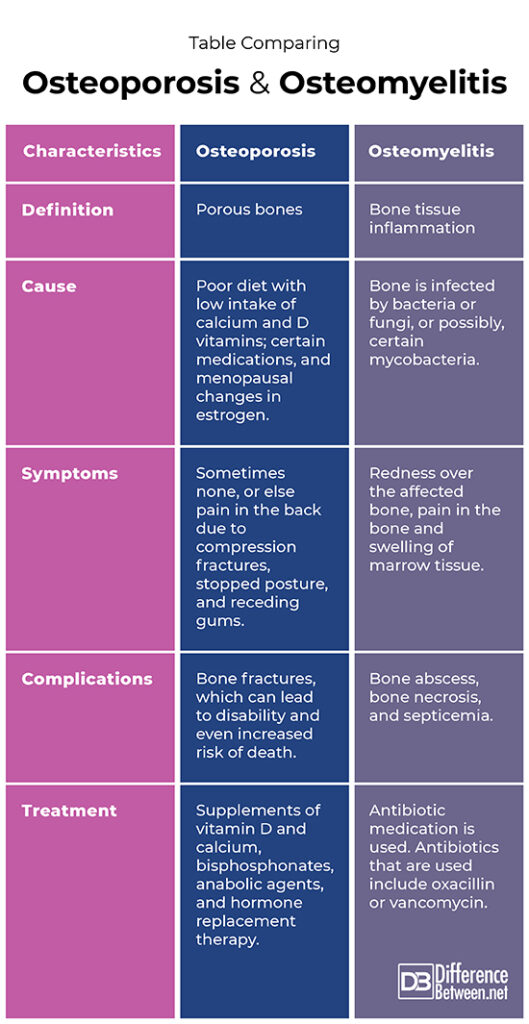Difference Between Osteoporosis and Osteomyelitis
Osteoporosis is a condition where bones are porous. Osteomyelitis is a condition where bones are inflamed.

What is Osteoporosis?
Definition:
Osteoporosis is the condition where bone mineral density is decreased, resulting in porous bones.
Causes:
A low intake of calcium and vitamin D can result in osteoporosis as you age. At menopause, women experience a drop in estrogen, which also increases the risk of bone loss. Certain medicines used to treat seizures and hormonal treatments used to treat reproductive cancers can lead to bone loss.
Symptoms and complications:
At first, a person may have no indication that they have osteoporosis. However, back pain can occur when compression fractures happen in the vertebrae. The person may also lose height over time and begin to have a stooped posture. Fractures can result in disability and even death.
Diagnosis:
Diagnosis is confirmed by the results of a dual-energy x-ray absorptiometry (DXA scan). This scan measures bone density and can indicate that a person has porous bones. A vertebral fracture assessment (VFA) is a test used in combination with a DXA to indicate if there are fractures in the spinal bones.
Treatment:
Treatment of osteoporosis aims to preserve whatever bone is still present and help alleviate pain and other symptoms. Treatment options include using calcium and vitamin D supplements, using antiresorptive drugs such as bisphosphonates, using hormone replacement therapy, and certain medications that affect parathyroid hormone levels.

What is Osteomyelitis?
Definition:
This is when the osseous (bone) tissue is inflamed because of an infection.
Causes:
A bone infection is most often because of bacteria that have invaded the bone and marrow cavity. However, there are occasions when fungal organisms and mycobacteria have been the cause of osteomyelitis. Most often, the infection in the bone tissue is from an infection that originates elsewhere in the body. However, a traumatic injury where bone is exposed to the outside can also make infection likely.
Symptoms and complications:
Bone pain is the most common sign of osteomyelitis, but there can be other signs as well, such as redness and swelling over the infected bone. Fatigue and fever may also occur in response to the infection in the bone tissue. Bone necrosis is a possible complication of osteomyelitis.
Diagnosis:
Blood tests and X-ray scans can help in diagnosing osteomyelitis. Certain inflammatory markers in the blood can show that an infection is present. A bone biopsy and culture can show what pathogen is involved.
Treatment:
Antibiotics are used to treat the infection causing bone inflammation. Examples of antibiotics used include oxacillin and vancomycin.
Difference between Osteoporosis and Osteomyelitis
Definition
Osteoporosis is when bones are porous because of a lack of minerals. Osteomyelitis is when there is an inflammatory reaction in the bones.
Cause
Osteoporosis can be due to a couple of factors, such as a lack of vitamin D and calcium, hormonal changes of menopause, hormone therapy, and ant-seizure drugs. Osteomyelitis is due to bone tissue invasion by some type of pathogenic microorganism.
Symptoms
The symptoms of osteoporosis include pain in the bone, a decrease in height, stooped posture, and fractures of the vertebrae. The signs of osteomyelitis include pain in the bone, a marrow cavity that is swollen, and a red appearance over the affected bone.
Complications
Complications that can happen with osteoporosis include bone fractures, which can cause disability and death. Potential complications of osteomyelitis include bone ulcers, bone necrosis, septicemia, and cellulitis.
Treatment
Osteoporosis can be treated with calcium and vitamin D supplements, anabolic agents, bisphosphonates, and hormone replacement therapy. Osteomyelitis can be treated using antibiotic medications, such as vancomycin and oxacillin; sometimes, damaged bone needs to be surgically removed.
Table comparing Osteoporosis and Osteomyelitis

Summary of Osteoporosis Vs. Osteomyelitis
- Osteoporosis is a metabolic bone problem.
- Osteomyelitis is due to an infection of the bone tissue.
- Supplements help with osteoporosis, while antibiotics help treat osteomyelitis.
FAQ
What can be mistaken for osteomyelitis?
The condition known as Charcot’s joint can be confused with osteomyelitis.
Is osteopenia the same as osteomyelitis?
No, osteopenia is not the same. Osteopenia is a decrease in bone density, while osteomyelitis is inflammation of the bone.
Is osteonecrosis the same as osteomyelitis?
No, osteonecrosis is actual bone death, while osteomyelitis is inflammation of the bone.
What is the most common bone site of osteomyelitis?
Osteomyelitis normally affects the hip bones and sometimes vertebrae.
Which bone is most affected by osteomyelitis?
In children, long bones of the limbs are most affected by osteomyelitis. In adults, vertebrae, hip bones, and feet bones are most affected by the condition.
What are the two 2 types of osteoporosis?
There is a type I (post-menopausal) osteoporosis and type II (age-related) osteoporosis. Type I osteoporosis is found in women after menopause because of changes related to estrogen. Type II osteoporosis is a feature of aging, with people losing bone with age due to a long-term lack of calcium in the diet.
What are two tests that can identify osteoporosis?
A DXA scan and a VFA test are used to identify osteoporosis. The DXA scan shows bone mineral density while the VFA can show fractures in the vertebrae.
What are 5 symptoms of osteoporosis?
Five symptoms of osteoporosis include receding gums, a loss of height, stooped posture, lower back pain, and fractures.
- Difference Between Rumination and Regurgitation - June 13, 2024
- Difference Between Pyelectasis and Hydronephrosis - June 4, 2024
- Difference Between Cellulitis and Erysipelas - June 1, 2024
Search DifferenceBetween.net :
Leave a Response
References :
[0]Bolster, Marcy B. “Osteoporosis”. Merckmanuals. Merck & Co., 2022, https://www.msdmanuals.com/professional/musculoskeletal-and-connective-tissue-disorders/osteoporosis/osteoporosis
[1]Prokesch, Bonnie C., et al. "Primary osteomyelitis caused by hypervirulent Klebsiella pneumoniae." The Lancet Infectious Diseases 16.9 (2016): e190-e195.
[2]Schmitt, Steven. “Osteomyelitis”. Merckmanuals. Merck & Co., 2022, https://www.msdmanuals.com/professional/musculoskeletal-and-connective-tissue-disorders/infections-of-joints-and-bones/osteomyelitis
